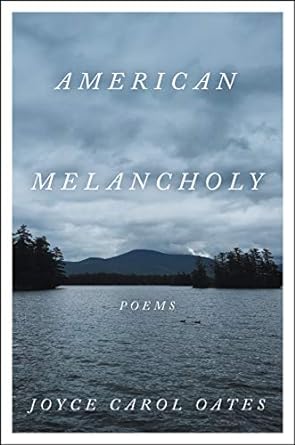News
Article
Revisiting the Ethics of Landmark Psychological Experiments in American Melancholy: Poems
Author(s):
“Oates’ poems force us to reflect on the ethics of experimentation and to ask if the proverbial ends justify the means.”
COMMENTARY
My encounter with Joyce Carol Oates’ poetry collection, American Melancholy: Poems,1 was unplanned—but much appreciated for the content that it is (not necessarily for the poetry part).

I had opened my Scribd app—which is a subscription-based smorgasbord of top-quality written or audio works—and searched for a specific history of psychiatry book by the same name. I expected to find American Melancholy: Constructions of Depression in the Twentieth Century by Laura Hirshbein2—but that book was nowhere to be found. Instead, up pops this poetry collection in audiobook form, narrated by Cheryl Smith and published by HarperAudio. I could not resist clicking.
Now, let me confess: I am completely unqualified to critique poetry, having taken but a single college course on the subject. If anything, I am inclined to read Wordsworth or maybe Robert Frost or even Dr Seuss when the opportunity arises. My own poems about nature, however childish they sound, must rhyme. In my mind, to rhyme is sublime, and I am completely clueless when it comes to more contemporary approaches to poetry, which sound to me like prose but without punctuation.
Despite my naivete, I was gripped by the first few poems in Oates’ collection, which was her first collection in 25 years.1 It is nearly impossible to be unfamiliar with Oates’ name, given that she is so prolific a novelist who has won many, many awards for her novels and plays. Her name appears in the mainstream media often enough that one need not read her works to know of her works.
But her poems about experimental psychologists Harry Harlow and John B. Watson and Stanley Milgram took me totally by surprise—and gripped me in a way I never expected—even though I had learned about their landmark experiments in basic college psychology courses, which most of us took at one point in time. It was only later that we backtracked and questioned the ethics of the dubious techniques used to achieve their glorious results.
Let me explain.
In the opening chapter of American Melancholy, Oates tells the tale of pioneering behaviorist, John B. Watson (1878 to 1958), explaining his experiments that induced a lifelong phobia in a little boy, known only as Little Albert. Watson’s goal was to prove that phobias could follow from later life traumas, bypassing consciousness altogether, without not necessarily stemming from family dynamics or interrupted developmental stages, as posited by opposing psychoanalysts who followed in the footsteps of Freud.
Watson wanted to revisit the recently discovered “classical conditioning” and to confirm its validity—and in that endeavor, he succeeded. He also succeeded in creating one of psychology’s most controversial—and well-remembered—experiments.
Little Albert’s definitive identity remains a matter of speculation, but the cause of his death at age 6 years is known. He was a human test subject at 9 months old who eventually succumbed to hydrocephalus. Because of his early death, we do not have long-term follow-up about his later psychological states, although it is generally agreed that he was developmentally delayed probably because of his congenital medical condition.
Albert was exposed to white rats while Watson (or his assistant) clanged on a loud iron bar, with the intention of inducing a reflexive fear response that would then be paired with the rat through what became known as “paired associational learning.”
We know that Albert was not initially afraid of the rat. What we also know is that he not only became afraid of white rats, even in the absence of the loud sound—his fear of furry white rodents generalized to other fluffy white objects, including rabbits, stuffed toys, and, by some reports, even Santa Claus’ white beard.
We wonder if this unfortunate Little Albert lived a tortured existence during his few short years on Earth because of this experiment, but that inference cannot be confirmed.
Although Watson made an important contribution to our understanding of the genesis of phobias and other avoidant behavior, there is no doubt in my mind that he would be behind bars had he conducted these experiments today. Albert’s mother, who volunteered her infant son for the experiments, might find herself in an equally sad situation, pursued by CPS and probably charged with child abuse.
Such human experimentation lies on the continuum of the experiments prosecuted at Nuremberg, with the exception that this psychology experiment involved only 1 individual rather than hundreds or millions.
Next, Oates jumps to psychologist Harry Harlow (1905 to 1981), who remains renowned for his experiments with Rhesus monkeys in general and with terrycloth monkeys in particular. He is famed for proving the need for close contact with a mothering figure and for confirming the risk of adverse consequences in the absence of a nurturing figure, or from simple social isolation.
Harlow separated his monkeys from their natural mothers and instead subjected them to contact with wire hangers shaped like monkeys or with terry cloth-covered wire hangers. The monkeys favored the softer terry cloth figures over those made from wires alone—even if the wire monkey held food while the terry cloth one did not. Harlow proved that a cuddly enough object made a great deal of difference in development.
Should anyone believe that the monkeys with the terry cloth mothers lived happily ever after, Oates reminds us that none of the monkeys left Harlow’s lab alive. She offers even more gruesome facts about those monkeys, which are too gruesome for me to recount here, except to say that the details could turn almost anyone into a card-carrying member of PETA.
Some hypothesize that Harlow’s experiments spurred the rise of the animal liberation movement in America. Still, Harlow received many awards, including, but hardly limited to, the National Medal of Science (1967) and a Distinguished Psychologist Award from the American Psychological Association in 1960.
Moving on, Oates explores psychologist Stanley Milgram’s experiments, which have received extra attention in recent years. Milgram attempted to explain how supposedly civilized individuals could be goaded into participating in mass murder during WWII.
Using shills and simulated electric shocks, Milgram showed that college students could be cajoled into following orders doled out by a “superior” to the point that they (supposedly) shocked their classmates to death when given the order to raise the voltage of the simulated shocks. Even though the unseen electric shocks were fake, the screams coming from the other room sounded real enough to convince the participants that they were indeed causing excruciating pain and killing their classmates.
Oates contends that the participants in the experiment were traumatized forever after, although she does not cite any studies that support those inferences.
Even without statistical corroboration, Oates makes her point—and that point is amplified by the affect in her narrator’s voice. In short, some experimental techniques that were acceptable at one point in time would be totally unacceptable today—even if those results changed our understanding of behavior and psychopathology and possibly led to the prevention of impending disease. And history reminds us that not all medical experiments have produced useful data either for their participants or for future generations.
Although we cannot turn back the clock to predict how the history of experimental psychology would have shifted if stricter controls had been in place when these landmark experiments were conducted, Oates’ poems force us to reflect on the ethics of experimentation and to ask if the proverbial ends justify the means. They function as cautionary tales, and not as entertainment.
Something tells me that I got the better deal when I chanced upon this collection of American Melancholy and accidentally detoured from my original and more standard destination.
Dr Packer is an assistant clinical professor of psychiatry and behavioral sciences at Icahn School of Medicine at Mount Sinai in New York, New York.
References
1. Oates JC. American Melancholy: Poems. Ecco; 2021.
2. Hirshbein LD. American Melancholy: Constructions of Depression in the Twentieth Century.Rutgers University Press; 2009.
Newsletter
Receive trusted psychiatric news, expert analysis, and clinical insights — subscribe today to support your practice and your patients.





